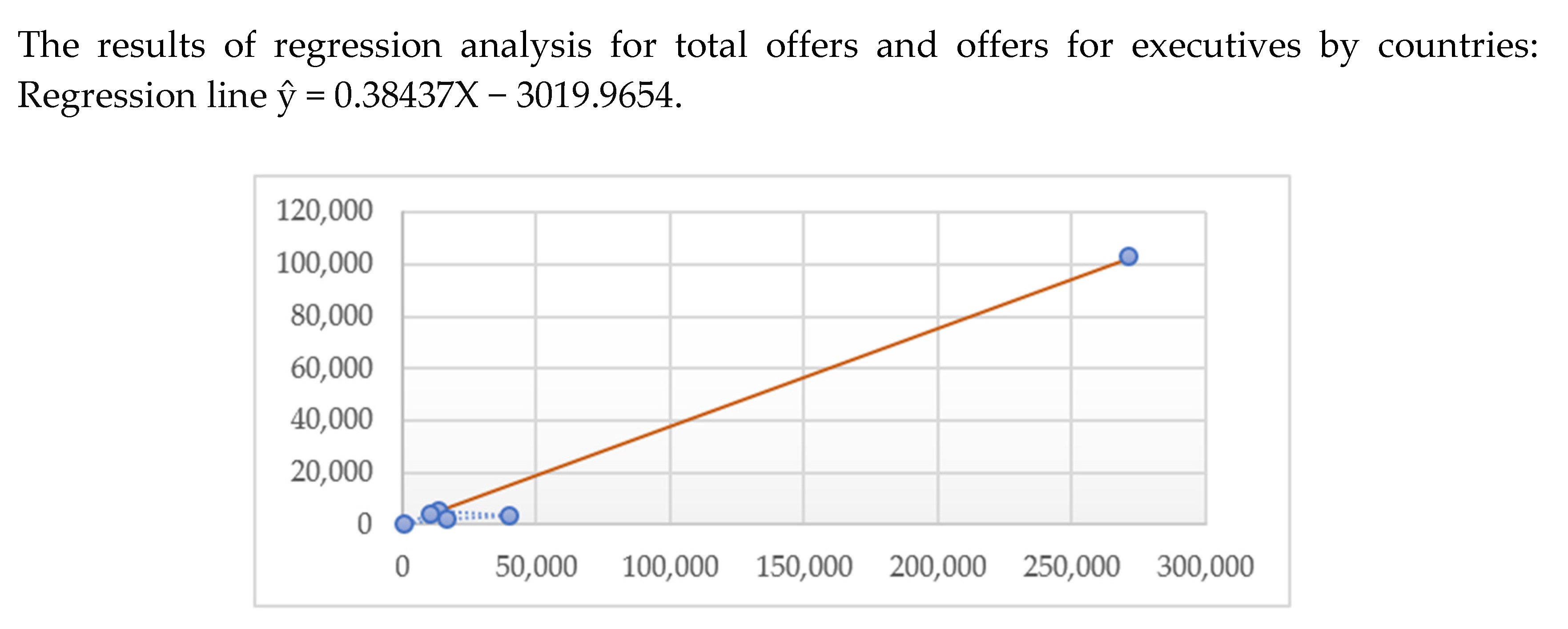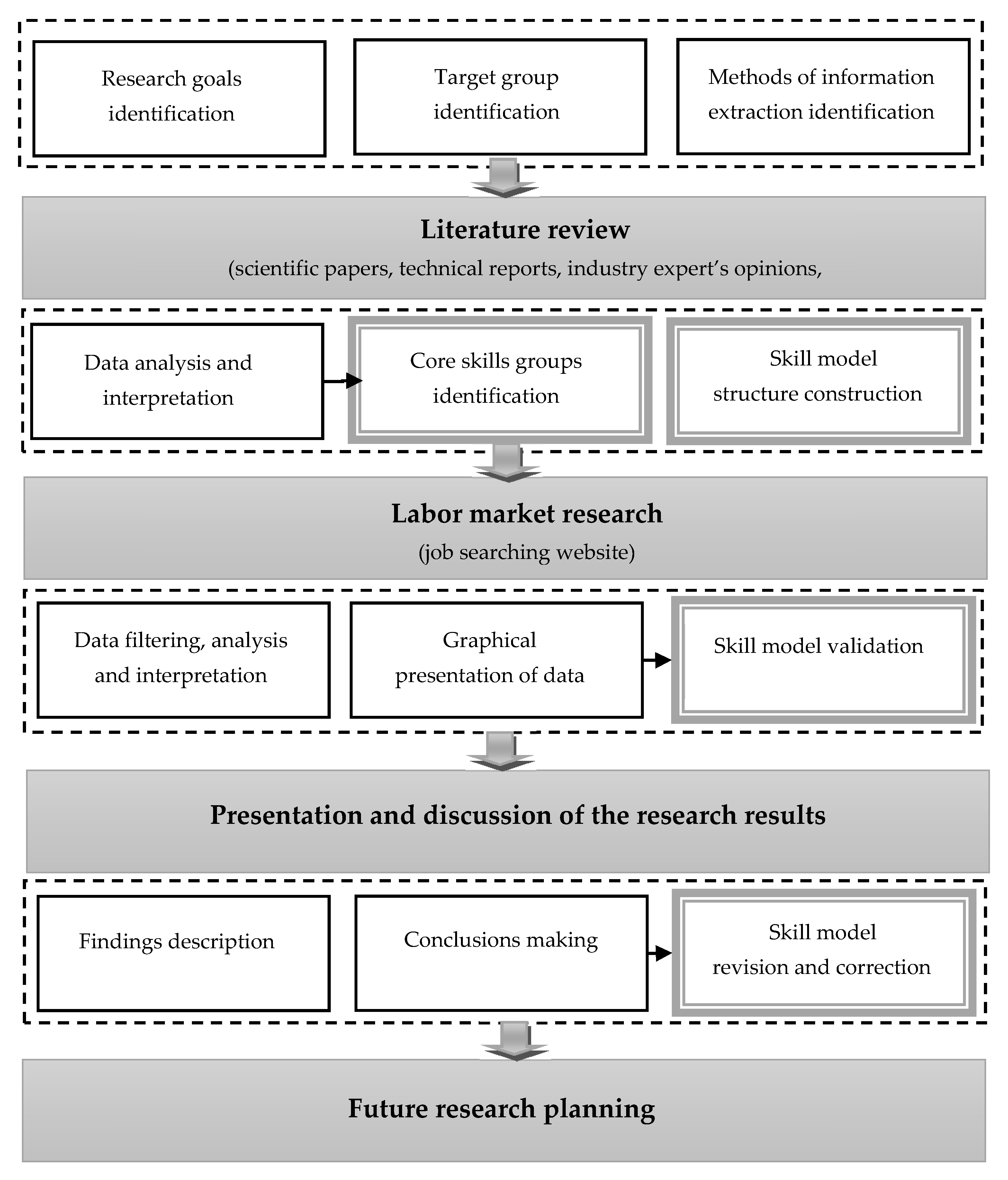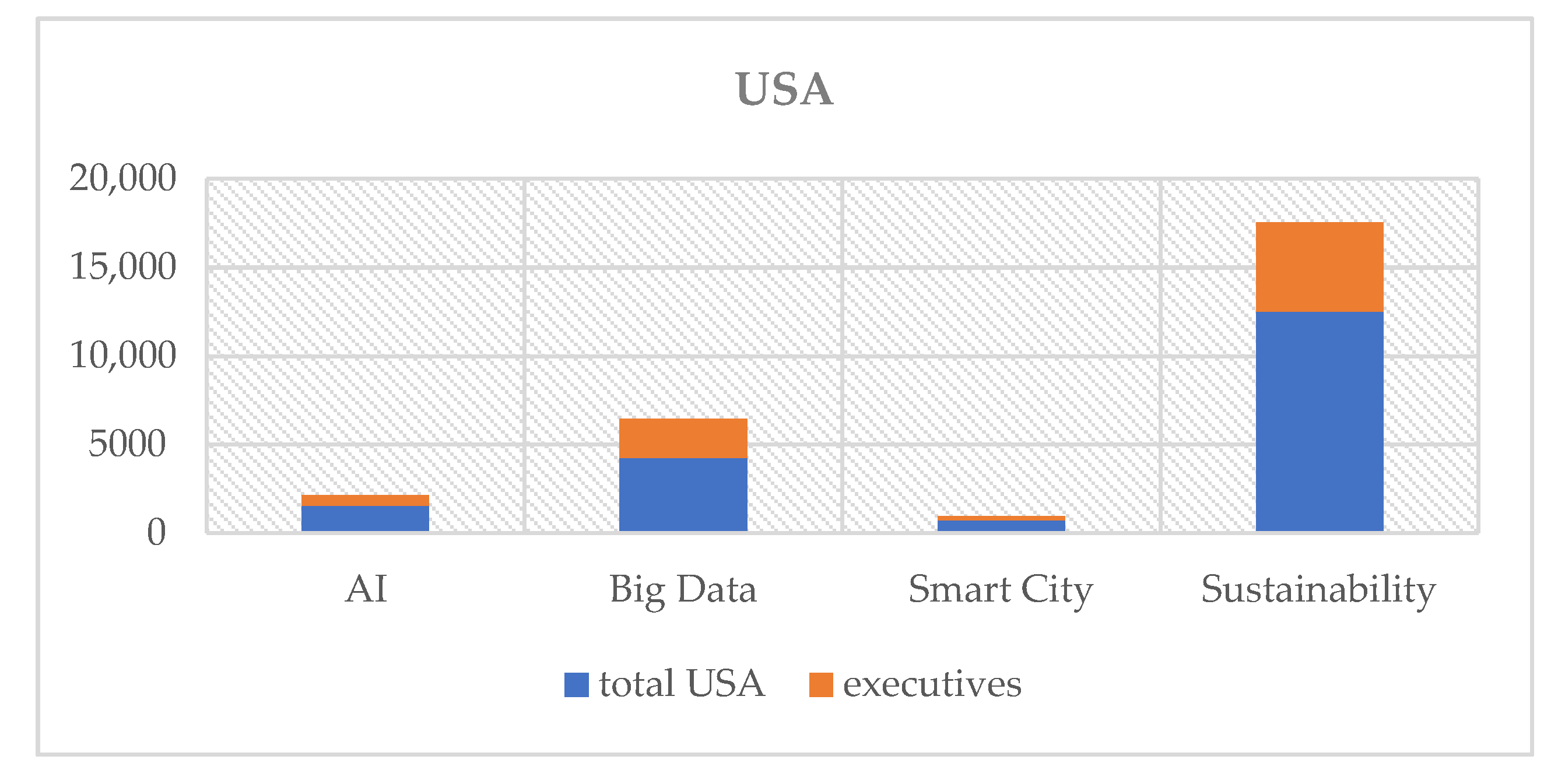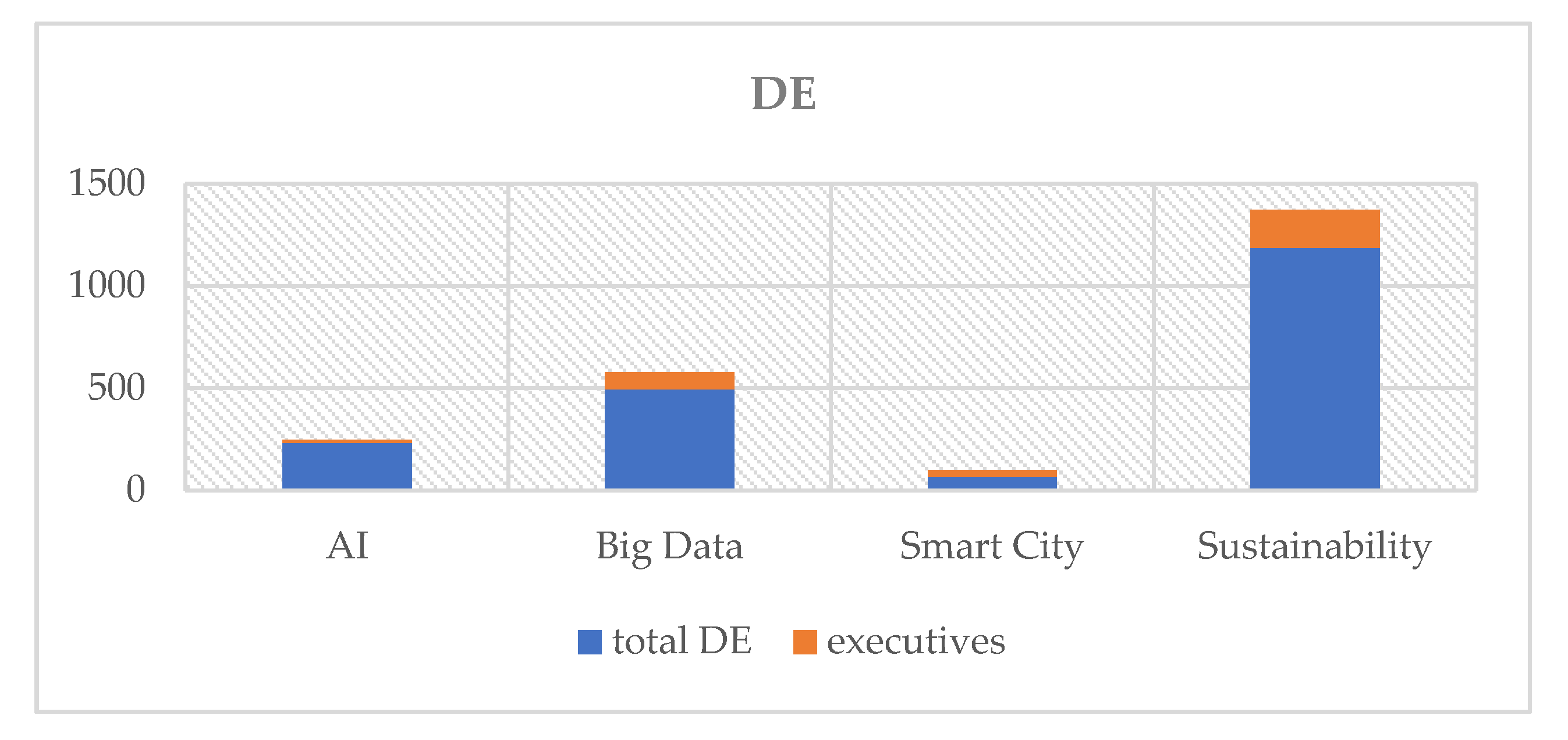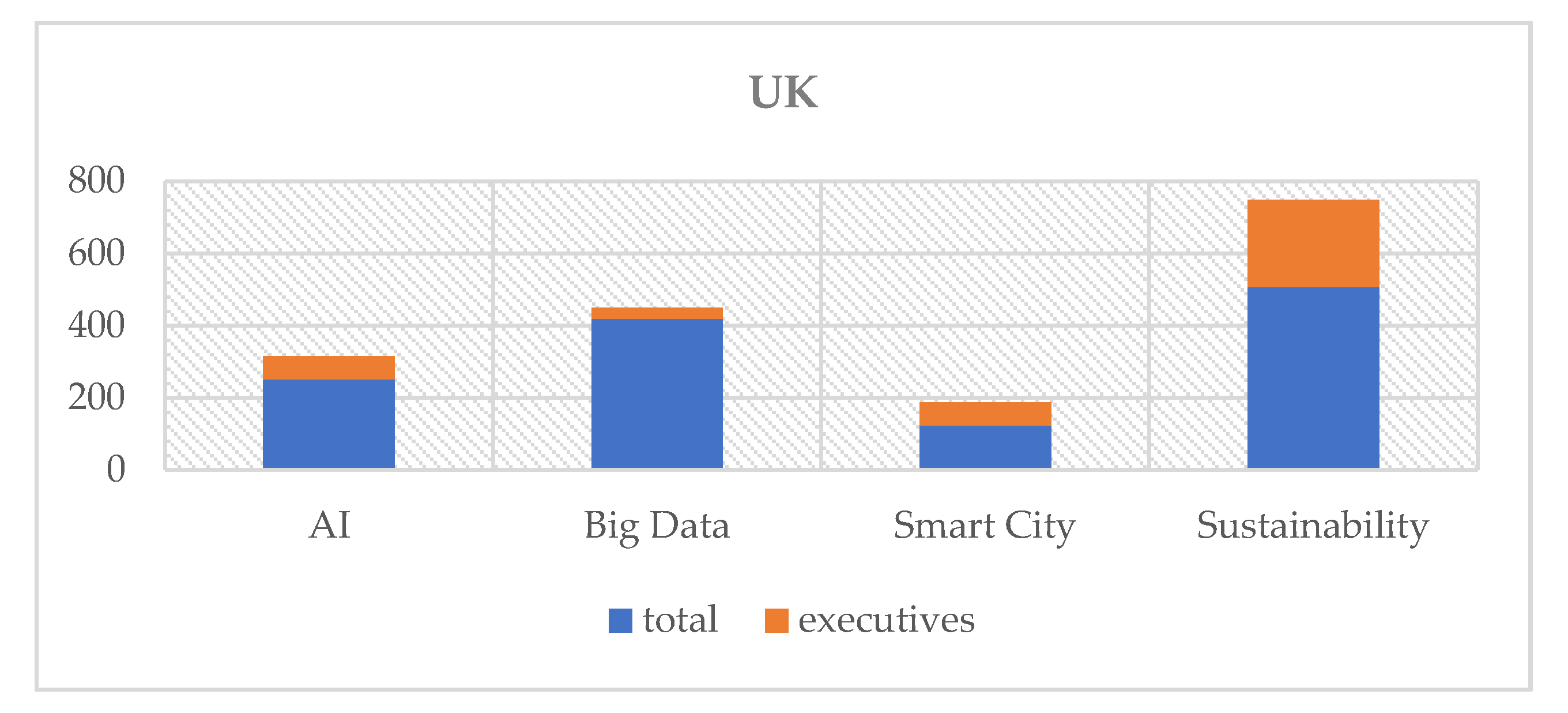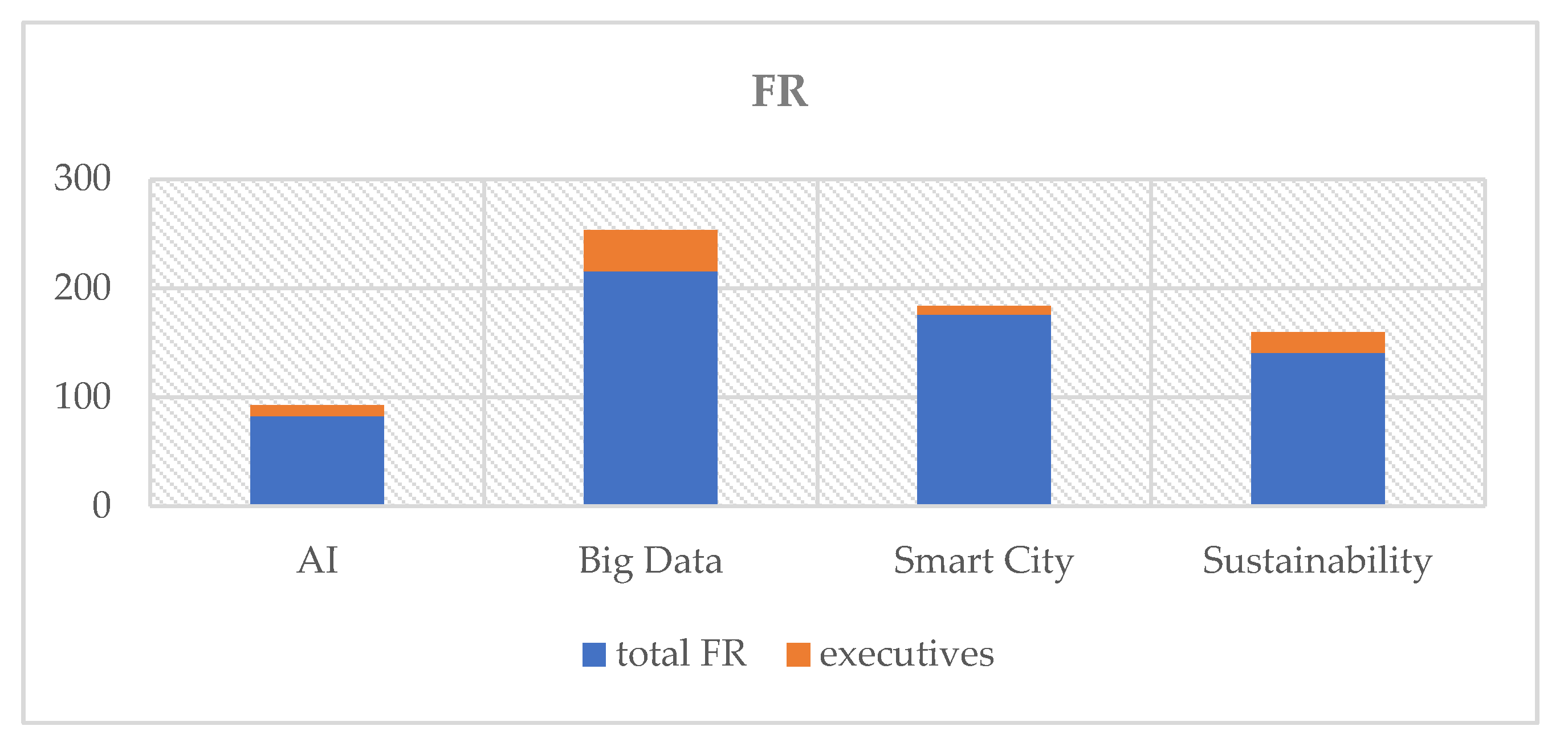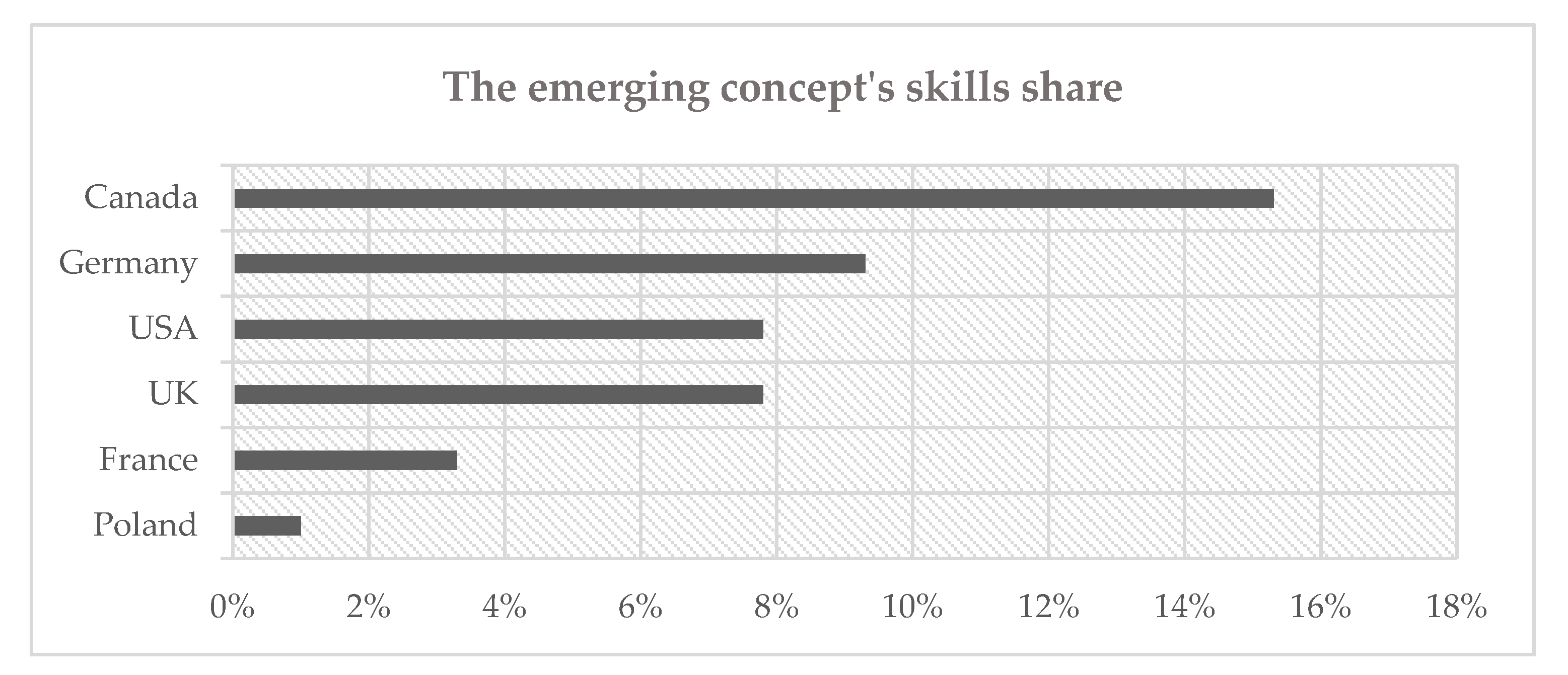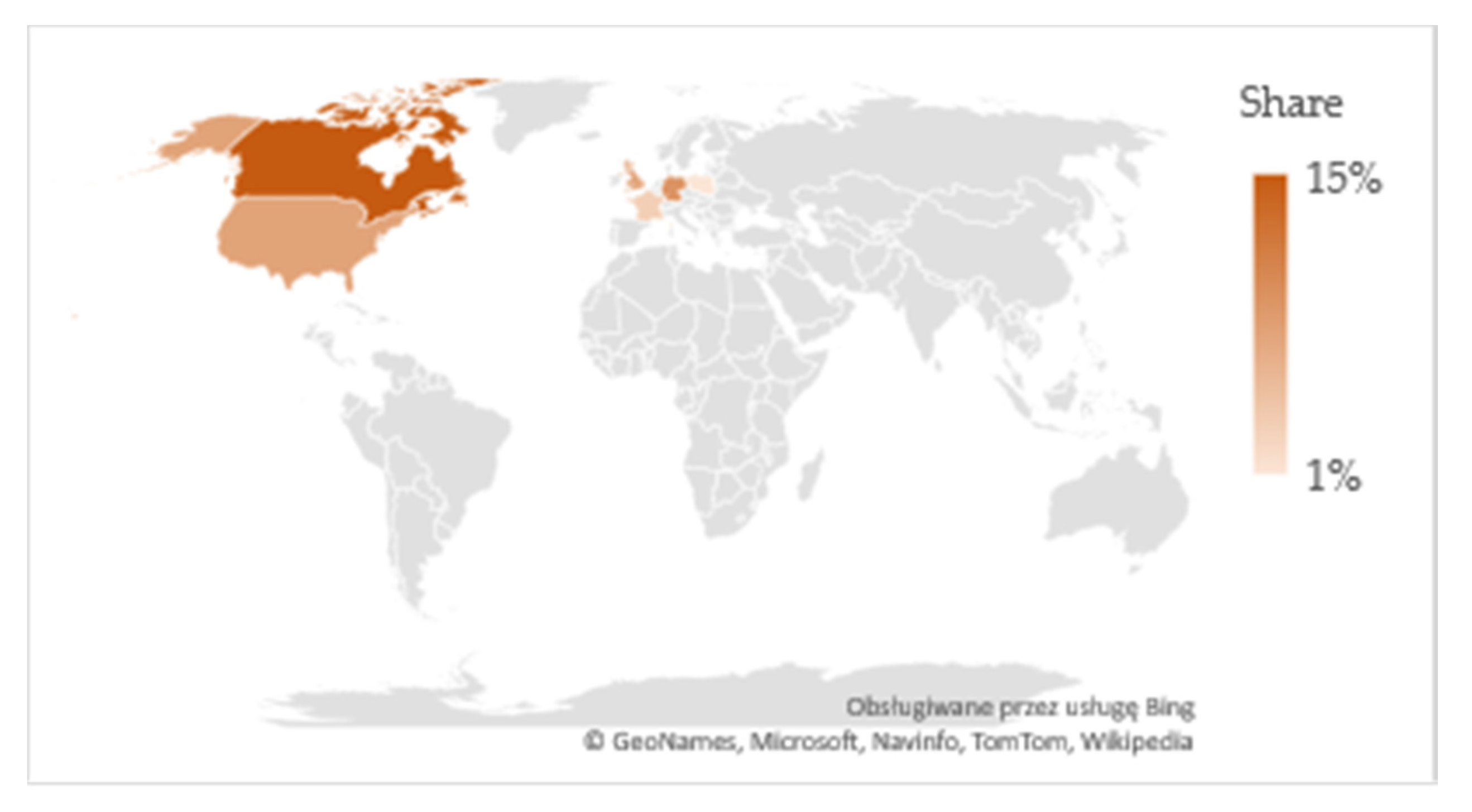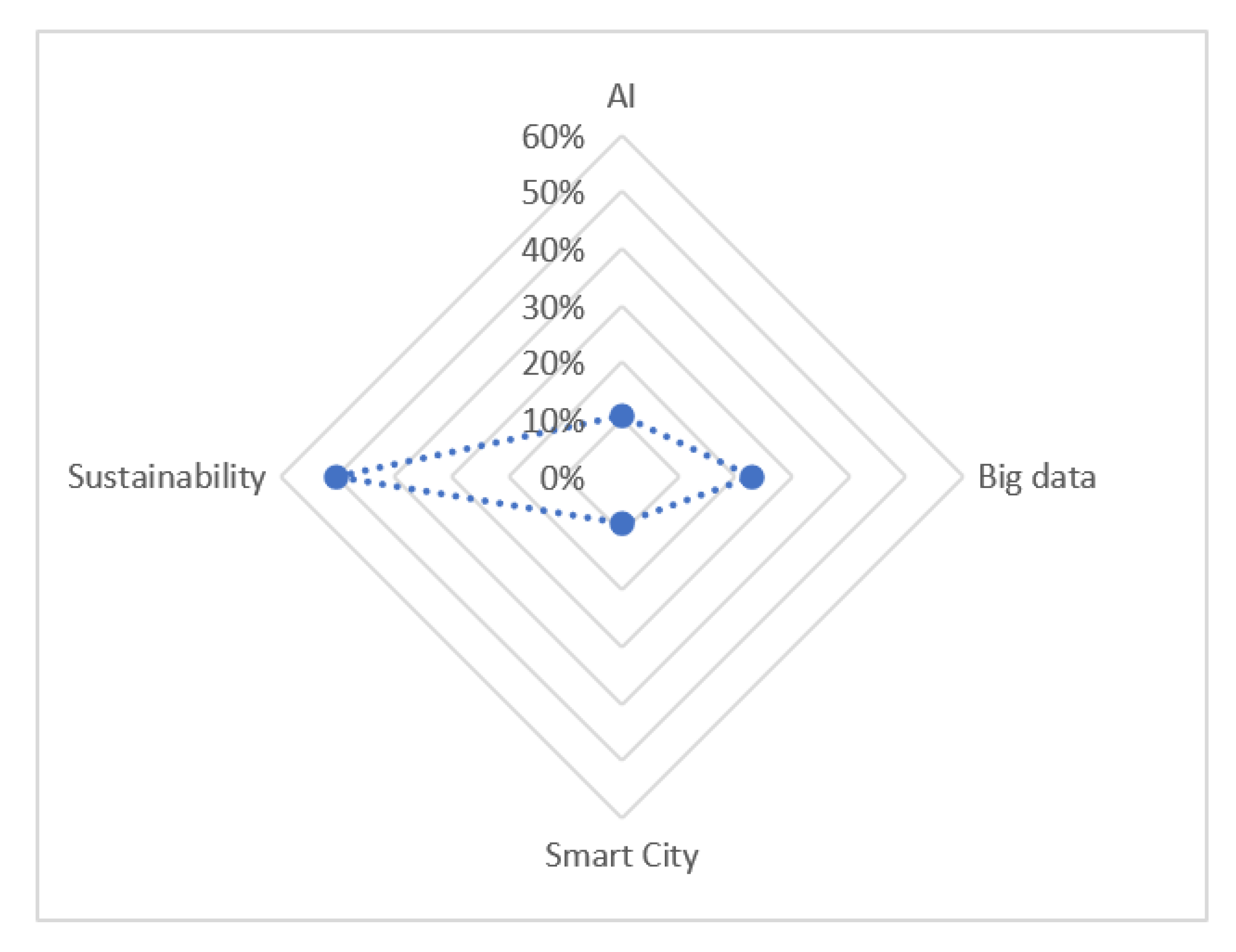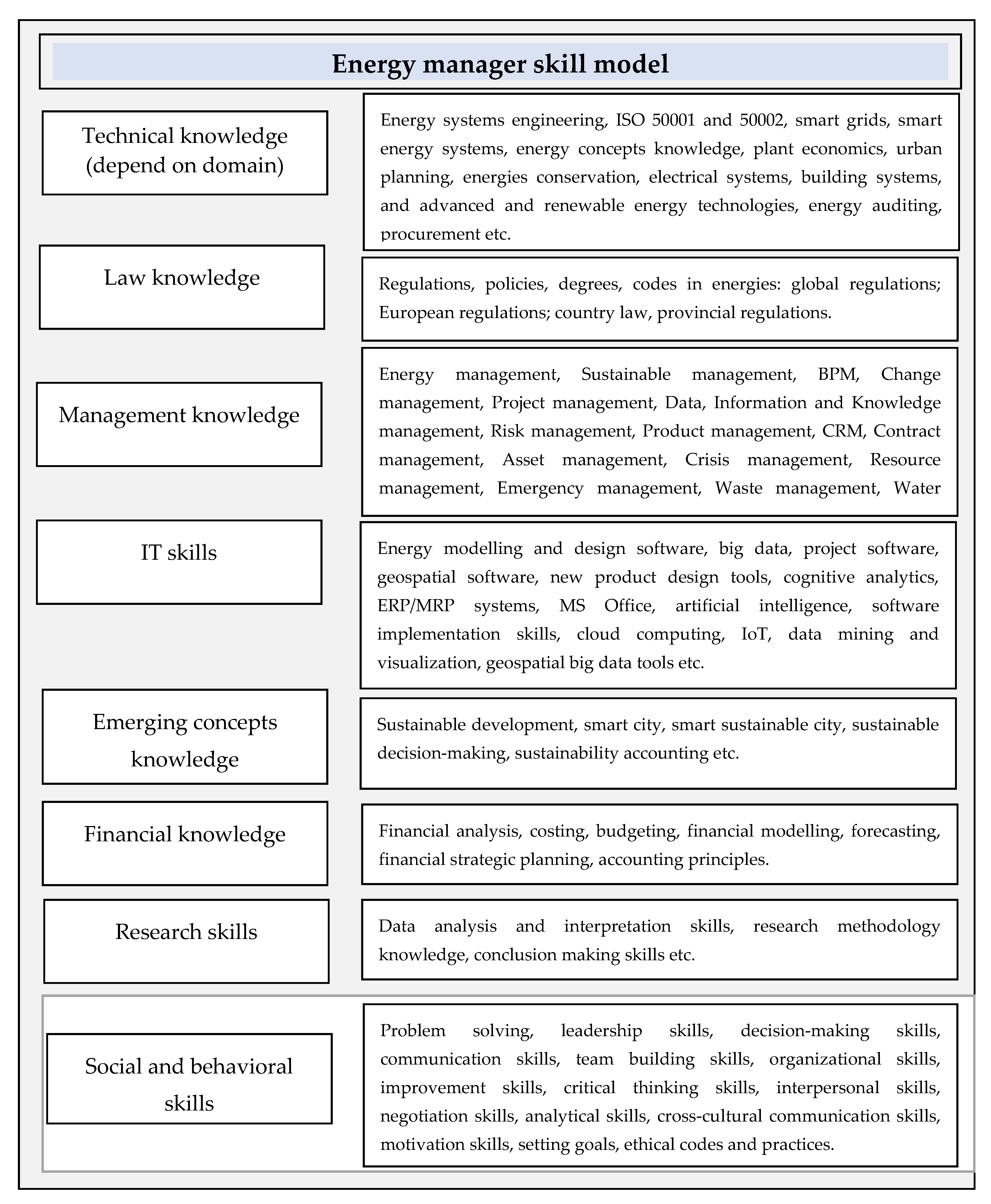The first stage of the procedure covers the research objectives identification and target group selection. The target group of energy managers job positions was chosen. At the same stage, data collection methods were selected. Among different methods, the literature review and labor market survey were chosen to fulfill the research gap. At the next stage, the literature study was conducted, and the skill model main structure was created. The general structure of the model was constructed by integrating the skills into main groups and subgroups and providing appropriate competencies for each group.
To evaluate the literature study results, labor market research was conducted. At this stage, data filtering, analysis, interpretation, and graphical presentation were used. In other words, the skill model validation was carried out. The last stage was the model revision and correction. The skills and abilities that frequently appear in job posts and were not identified earlier as a result of the literature study were added to the model. The abilities that do not appear in the labor market analysis were excluded from the model.
2.1. Literature Review
In scientific research, energy management is considered as a key element of complex energy systems for smart cities [
25].
The review of energy big data digitalization systems in the energy sector reveals the challenges mentioned in the managing of volume, variety, and velocity of the data [
26]. “Therefore, big data is the essential technology to realize the paradigm shift in the energy sector” [
27]. Some papers investigate the energy big data sources. In [
26], the authors distinguished two groups of data sources: electric utility data and supplementary data [
26,
28]. Supplementary data could be obtained from such data sources “as geographical information system (GIS) data, global positioning system (GPS) data, time-reference data, weather and lightning data, seismic reflection data, animal migration data, financial market data, social media data and regulatory reporting data” [
26].
Several essential technologies support the introduction of big data applications to the energy sector [
29,
30]: smart grid, Internet of things (IoT), and cloud computing [
31,
32,
33].
Big data accompany the different processes in the energy industry starting from production, through logistics, and to consumption [
34]. Actually, big data technologies help process continuous improvement, for example by influencing the increase of fuel efficiency [
35].
In the energy sector, big data are coordinated, analyzed, and effectively applied to big data analytics. These analytics provide sophisticated energy services [
36,
37]. Big data analytics helps generate accurate forecasts of energy consumption, which affect power generation from renewable energy sources and pricing [
10,
27].
Moreover, it was observed that “big data technologies - combined with artificial intelligence, namely the new ‘engine’ of the Fourth Industrial Revolution and IoT infrastructure management enablers—constitute a catalyst towards conceptualizing and generating innovative applications and services for energy management” [
38], especially in terms of sustainable development.
The book “Energy management for sustainable development” provides a forum on policies and strategies as well as technologies to describe and discuss energy management issues in terms of achieving sustainable development in many energy sectors [
39]. The authors discussed the current environmental problems among many countries, such as China, Nigeria, the United States, Taiwan, and those in the sub-Saharan region, and proposed various ways solutions.
Many authors highlight the meaningful role of big data technology applications for design, planning, and managing smart and sustainable cities [
40,
41,
42,
43].
The sustainability concept, urban growth, and technological development have been converged under the “smart sustainable cities” concept [
44,
45]. Such a city “is supported by the massive use of advanced ICT in connection with various urban domains and systems” [
44].
In their work “Towards sustainable smart cities” [
41], the authors described the main trends and current challenges taking place in the smart city concept. They also discussed premises for the convergence of sustainability and smart city concept creating a new one “sustainable smart city” concept. They described the architecture, main characteristics, and the ways of implementation of smart city projects into the practice.
In [
42], the authors discussed the role of smart energy systems for sustainable smart cities. They concluded that a smart city needs intelligent approaches to manage and coordinate the diverse range of technologies applied.
Detailed overviews of different aspects of sustainable and smart cities are offered in the Sustainable Cities and Society (SCS) journal. This international journal presents many works with the focus on “fundamental and applied research aimed at designing, understanding, and promoting environmentally sustainable and socially resilient cities” [
43].
The authors of [
46] described the current developments in the smart energy sector, highlighting emerging key challenges and outlining future perspectives for the industry. Among many others, they argued “that smart city need for intelligent approaches to manage and coordinate the diverse range of supply and conversion technologies”.
“A smart city is a city that uses technological advances (such as IoT, big data, cloud computing, AI, etc.) to transform itself into an innovative ecosystem, concerned with achieving the wellbeing of its citizens, with special attention to sustainable development” [
47].
The authors of [
48] stated that the smart city concept has been introduced as a model for developing the city of the future, and most improvements and transformations in this model are based on energy aspects.
Forty-three smart city definitions, assessed according to the different dimensions of sustainability, were identified [
49].
The authors of [
50,
51] described the fundamental and synergistic elements of a smart city: the technology, economy, and management of energy resources that allow sustainable development, as well as the perception and social concern about these issues.
The authors of [
52] provided guidelines for energy management and how to help an organization improve its energy and financial performance in a way to distinguish the organization as an environmental leader. In [
9], the authors provided 16 guidelines of smart city statute for increasing its intelligence and making them smarter.
The authors of [
53,
54,
55,
56] analyzed the relationship between the smart city and the concept of energy sustainability and confirmed the correlation of these two concepts.
Some papers are focused on smart city solutions challenging with mobility problems [
57,
58]. The authors of [
57] presented a reference framework which supports the decision-making processes of public and private organizations. This framework serves as the basis for design and development of the proposed smart city mobility solution.
Several works highlight the emphasis of big data on geospatial systems [
59,
60,
61,
62]. They are the essential element of the smart city. Geospatial big data systems work with many geospatial data retrieved from a smart city environment.
The cognitive technologies create the next opportunity for increasing the energy management efficiency. “Fuzzy cognitive map is an established methodology for scenario analysis and to support a decision-making process in energy industry” [
63]. Cognitive radio systems are tools for energy-efficient design of channel sensing [
64,
65]. The cognitive technologies are also helpful during the renovation phase of buildings. “The cognitive layer defines the appropriate rules for opening and shading using the decision tree algorithm applied to the data generated by the sensors in order to infer users’ preferences” [
66]. Cognitive visualizations help to provide the appropriate information interpretation in the gas and oil industry [
67]. They are able to present large amounts of information in terms of one energy manager dashboard.
Moreover, the relationship of artificial intelligence and sustainability has been highlighted by many authors [
68,
69,
70,
71]. Artificial technologies have also been used for prediction in energy industry.
According to Accenture, “As artificial intelligence takes on an increasing number of tasks, managers will likely need to strengthen innately human skills—such as collaboration and social networking” [
72].
Another technology that has a growing influence on energy management is IoT. The energy demand of IoT applications is increased, while IoT devices continue to grow in both number and requirements. Therefore, smart city solutions must have the ability to efficiently utilize energy and handle the associated challenges [
25].
The authors of [
73] presented “the efforts on optimizing energy consumption by deploying an energy management system using the current IoT component/system/platform integration trends through layered architecture”.
The authors of [
74] argued that IoT “transforms simple building energy management into smart building energy management”. It also helps increase the building’s security, which helps to provide “real-time/predictive visualizations integrating historical IoT sensor data with real-time IoT sensor data”.
Another paper provides a framework for energy-efficient optimization and scheduling of IoT-based smart cities [
25]. It also discusses the energy harvesting in smart cities, “which is a promising solution for extending the lifetime of low-power devices and its related challenges” [
25].
Moreover, “IoT can help to improve energy efficiency, increase the share of renewable energy, and reduce environmental impacts of energy use” [
75].
The authors of [
76] described the sustainable environment for IoT and provided an overview of green IoT and “the challenges that are faced due to excessive usage of energy hungry IoT devices” [
76]. “Green IoT envisions the concept of reducing the energy consumption of IoT devices”.
Cognitive IoT is a relatively new domain of research and has not been explored enough to analyze deeply its influence on energy management [
77]. The authors of [
77] made attempts towards providing cognitive solutions for IoT usage.
In recent years, the new concept of Internet of Energy (IoE) appears. “IoE will allow energy exchange between a wide variety of sources and loads, including renewable energy sources, distributed energy storage, plug-in electric vehicles, domestic and industrial “prosumers” [
78].
To apply the above-mentioned emerging technologies in practice, enterprises need experienced energy managers with strong interpersonal skills “to build teams, foster innovation, and encourage new ways of working” [
79].
Summarizing the results obtained from the literature study, it was concluded that the main elements of the smart sustainable city concept which currently have significant impact on energy management are sustainability, big data, smart cities, artificial intelligence, and IoT.
However, technologies such as IoT, cloud computing, and cognitive computing are treated rather as technology solutions, not concepts in light of the energy manager profession.
Actually, the role of the energy manager has changed significantly. “In the 1970’s, the role of the energy manager was typified as a fire fighter using crisis management to keep the industry going” [
79]. With changing in energy analysis and valuation methods [
80], new concepts were created [
81], which changed energy management programs and policies and created new directions for energy managers in the 1980s [
79,
82]. Today, an experienced manager combines technical skills with expertise in financing, planning, strategy, communication, public policy analysis, creation, and interpretation [
80,
83].
Despite this, there is a lack of scientific papers on the challenges of energy manager profession transformation.
Dalton et al. highlighted the cross-cultural nature of today’s energy manager profession. They noticed the importance of law knowledge and value and social systems of different cultures/subcultures [
82]. The authors of [
84] described the interdisciplinary nature of smart organization and management in smart cities.
Ballini et al. described the role of energy manager and the meaning of resource management and ISO 50001 standard for energy managers [
83]. They proposed to use the results to develop future training and educational programs aimed to energy managers.
The role of an energy manager has changed also under the influence of complex digital control systems development [
85]. “Fulfilling the potential of these systems requires their operators to have the appropriate skills, which requires support for career-long learning” [
85].
More information on concrete abilities, competences, and skills are provided in several technical reports, studies, and articles [
86,
87,
88,
89,
90,
91,
92,
93,
94].
First, the experts noticed that, “to establish a successful energy program, the energy manager must have a good understanding of both the technical and managerial aspects of energy management” [
86].
According to Global Superior Energy Performance Partnership research [
87], energy managers need to have skills on every stage of the energy management process “from initiating an Energy Management Program, conducting an energy review, energy management planning, implementing energy management to measurement and verification”.
The authors of [
88] pointed out the meaning of the following skills:
“Social and behavioral skills: communication skills, technical leadership skills, organizational skills, time management, facilitation skills, setting priorities, strategic planning, team building, reading and comprehension, proficiency, conflict resolution, develop and track energy goals, analytical and policy interpretation skills”.
“Technical knowledge: math, algebra, statistics, data, energy concepts knowledge, strategic planning, analysis and trending, software skills, electrical, mechanical and process skills, and business fundamentals”.
“Project management (budgets, schedules, basic project costing, financial calculations, develop and manage project resources, project management software skills”.
Plant economics.
Research skills.
In their curriculum [
89], the authors mentioned the following skills requirements: project management, risk management, relationship management, BPM, change management, product management, IT management, software engineering, data analysis (statistics and big data), IT in production, energy technology standards, fundamental energy principles, energy measurement and assessment, energy effectiveness improvement, future energy prediction, energy systems projection, construction energy systems, and investigation of energy sustainability.
The technical skills and competences for a chief executive officer of energy according to Singaporean Skills Future Movement are [
90]: business planning management, problem solving skills, business stakeholder management, communication skills, business-to-business customer relationship management, decision making skills, continuous improvement management, sense making, advanced crisis management, emergency response management, resource management, risk and compliance management, and safe system of work development and implementation.
The model proposed in Global Superior Energy Performance Partnership research [
87] compares the skills needed in several countries such as Australia, the United States, Japan, Korea, and South Africa. The study reveals great differences in competence requirements. The model of competence was structured according to the energy management cycle. The highest requirements for energy manager job positions were noticed in Australia and the United States. In Australia, for example, energy management, change management, risk management, contract management, innovation skills, problem solving, communication, analytical, interpersonal, energy procurement knowledge, energy accounting, waste management, water management, and many other skills were required.
Moreover, ARCADIS underlines the importance of procedures and policies knowledge for energy managers. According to ARCADIS opinion, “the energy manager should be able to establish, implement and maintain its own procedures, conformity with the energy policy, and procedures, and the requirements of the Energy Management System” [
91].
On the other hand, according to the Australian Government, Department of Industry, Science, Energy and Resources, the energy manager is a person “with skills in communications, financial administration and information systems, and an understanding of technology” [
92].
Moreover, the Canadian Ministry of Natural Resources highlights the role of energy management training within enterprises. The Ministry states that “the one of the best ways to improve energy efficiency is through energy management training – that is, by making sure the staff are equipped to take full advantage of the energy-saving opportunities available to organization” [
93].
Currently, energy managers rather act as business partners instead of task managers [
94].
Energy managers should be up to date with current concepts and technologies. New concepts which have influence on energy sector appear in the last decades include sustainable value management [
95], sustainable supply chain management [
96], sustainable decision-making, smart sustainable city, intelligent energy management [
97], etc.
Summarizing the results of the literature review, it could be concluded that the energy manager profession is currently characterized by the following features:
- ▪
It needs continuous learning and requires high learning abilities.
- ▪
It is under the influence of emerging concepts and requires new concept knowledge.
- ▪
It is under the influence of emerging technologies and requires advanced IT skills.
- ▪
It requires financial and accounting knowledge.
- ▪
It requires procedures and policies knowledge.
- ▪
It requires strong leadership and communication skills.
- ▪
It requires strong analytical skills and statistics knowledge.
- ▪
It requires strong technological skills that depend on the sector and common mathematical and technological knowledge.
- ▪
It requires different management skills.
- ▪
It requires the abilities related to projecting new energy technologies and policies and research skills.
- ▪
It often has a cross-culture, international nature and thus requires language knowledge.
The growing popularity of the smart sustainable city concept is causing changes in the energy manager profession. The literature analysis reveals that many experts underline the need of continuous learning and skill improvement for energy managers. This profession asks for very skillful executives with knowledge in different domains and emerging concepts, such as big data and sustainability.
In this way, the energy manager becomes one of the most challenging professions of the future.
The core competencies and skills required for executive positions in the energy sector were found and selected for further validation.
Finally, the following skills were selected from different sources:
- ▪
Technical knowledge [
86,
88,
89,
92]: Energy systems engineering [
87,
89,
93], ISO 50001 and 50002 [
83], energy concepts knowledge [
86], plant economics [
88], urban planning [
15], energy conservation [
14], electrical systems [
87], building systems [
87], advanced and renewable energy technologies [
14], energy auditing, procurement [
15,
87], etc.
- ▪
Law knowledge [
94]: Regulations and policies [
86,
94].
- ▪
Management knowledge [
87,
90]: Energy management [
87]; sustainable management [
87]; BPM [
89]; change management [
89,
90]; project management [
88]; data, information, and knowledge management [
89]; risk management [
87,
89,
90]; product management [
89]; CRM [
89]; contract management [
87]; asset management [
90]; crisis management [
90]; resource management [
90]; emergency management [
90]; waste management [
87]; water management [
87]; etc.
- ▪
IT skills [
89]: Energy modeling and design software [
14], big data [
13], project software [
88], new product design tools [
87], cognitive analytics [
12,
13], artificial intelligence [
11,
12,
13,
72], software implementation skills [
90], cloud computing [
90], IoT [
13], data mining and visualization [
67], geospatial big data tools [
67], etc.
- ▪
Emerging concepts knowledge [
15,
86,
89]: Sustainable development [
89], sustainable decision-making [
87], sustainability accounting [
87], etc.
- ▪
Financial knowledge [
92]: Financial analysis [
83], costing, budgeting, financial modeling, forecasting, financial strategic planning [
83], and accounting principles [
87].
- ▪
Research skills [
88]: Data analysis and interpretation skills, research methodology knowledge, conclusion making skills, etc. [
88].
- ▪
Social and behavioral skills [
88]: Problem solving [
87,
90], leadership skills [
88], decision-making skills [
87], communication skills [
90,
95], team building skills [
88], organizational skills [
88], improvement skills [
87], critical thinking skills [
87], interpersonal skills [
87], negotiation skills [
87], analytical skills [
88], cross-cultural communication skills [
82,
84], motivation skills [
87], ethics knowledge [
87], and setting goals [
88].
In the next section, these competences are checked and analyzed by means of labor market research.
2.2. The Labor Market Research
The research was conducted in the summer of 2020. The first results were obtained at the beginning of July, and after that they were checked twice until the end of August. The procedure in line with the framework presented in
Figure 1 was used.
In the first stage, the most popular worldwide job search websites (according to the worldwide rankings) using Google search were selected. The following selection criteria were used: (1) the largest number of current energy executive published job posts; (2) applicability in the studied countries; (3) clustering by industry (already defining separately the “Energy” job group for energy sector); and (4) the ability to support “advanced search”. The use of English language in job posts also had a significant influence on the final choice.
The website comparison was carried out. Consequently, “Indeed” job search website was chosen. The jobs were browsed by “Energy” job group.
In this stage, the task was to acquire the similar requirements in energy manager skills among different continents and countries. The country selection was conducted according to the following criteria: geographical position (different continents and different European regions), technological development level, and high GDP level. The following countries were considered: the United States of America, Canada, Poland, the United Kingdom, France, and Germany. However, According to European Commission Joint Research Centre “the labor market impact of COVID-19 have been expected to be higher in some Southern European Member States and Ireland” [
98]. Thus, the European countries which noticed the high impact of COVID-19 (contracts lost) in July, such as Greece, Bulgaria, Romania, Spain, Slovenia, Ireland, and Italy, were excluded from consideration [
98].
About 352,000 job posts were processed. Job posts were filtered using “Indeed” website search engine by entering the following key words into the webpage search field: “artificial intelligence”, “sustain(ability)/(able)”, “smart city”, “big data”, “large data”, “large data sets”, “large amount of data”, etc. The position analysis was done with the following key words defined: “energy manager”, “energy director”, and “energy executive”. An identical research procedure was used for all selected countries.
The website searching mechanism found many relevant positions, such as sustainable materials manager, sustainable and environmental manager, sustainable strategy manager, sustainable project manager, sustainability solutions manager, energy performance manager, climate change manager, and energy efficiency manager.
In the next step, the number of job offers for energy executives (EE) and relevant positions including appropriate skills requirements were calculated. The amount of demand on energy managers positions reflects the influence of different concepts on energy management among countries. The results are presented in
Table 1. The column “Energy” presents the total number of offers in the energy sector and the number of offers for executives according to the website search engine by country. The following columns present the number of job offers requiring skills in artificial intelligence, big data, smart city, and sustainability concepts.
In the final stage of labor market research, the presence of competencies identified in the result of literature analysis was checked by adding the key words with competence titles to energy manager positions. For example, “energy manager”, “project management” or “energy manager”, “communication skills”, etc. are skills that appear in job posts and were not identified earlier as a result of a literature study, and thus were selected for further processing. The abilities that were identified during the literature study but did not appear in the labor market analysis were excluded from further processing.
